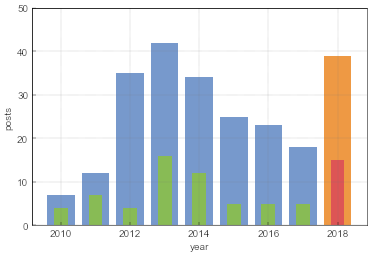Quite productive 2018
We had quite a lot of fun while exploring price formation topic as well as order book models back in 2018. The last year was our best year since 2013 as we have published 39 posts and 15 interactive models, while in 2013 we had 42 posts and 16 interactive models.
 Fig. 1:The number of posts written in English and still available on this iteration of Physics of Risk. The wide bars represent total number of posts for each year since 2010, while the narrower bars represent a number of posts with 'Interactive models' tag.
Fig. 1:The number of posts written in English and still available on this iteration of Physics of Risk. The wide bars represent total number of posts for each year since 2010, while the narrower bars represent a number of posts with 'Interactive models' tag.Note that our history stretches back into 2006 and some of the data is not reflected in the graph above. Here we do not account for the posts, which where written in Lithuanian only. While most of these are not lost and are safely stored, their recovery and proper translation is a bit more complicated matter.
So far the plan for this year (2019) is to continue our recently started series of posts on opinion dynamics. What will come next only the time will show.

